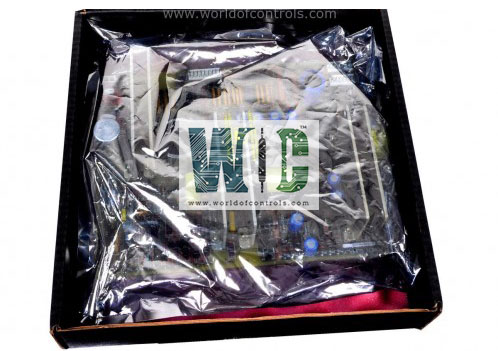SPECIFICATIONS
Part No.: IS200DVIBH1A
Manufacturer: General Electric
Country of Manufacture: United States of America (USA)
Temperature rating: 0 to 60 oC
Current suppression: MOVs
Product Type: Vibration Terminal Board
Availability: In Stock
Series: Mark VI
Functional Description
IS200DVIBH1A is a Vibration Terminal Board developed by GE. It is a part of Mark VI control system. The terminal board designed for DIN-rail mounting. It is a part of vibration monitoring systems. Its design and capabilities are tailored to meet operational standards, ensuring reliable performance in demanding conditions. The board is built to comply with the UL 1604 specification, which governs the safe operation of electrical equipment in hazardous locations. Specifically, it is rated for use in Class 1, Division 2 environments, which are areas where flammable gases, vapors, or liquids may be present under abnormal conditions. The board is capable of operating at temperatures up to 65oC, making it suitable for high-temperature industrial settings.
Input Capabilities
- 13 Vibration Probes: The board can connect up to 13 vibration probes, which are essential for monitoring the vibrational characteristics of machinery.
- Eight Vibration Inputs: These inputs are specifically designated for capturing detailed vibration data, which is critical for analyzing the operational integrity of rotating equipment.
- Four Position Inputs: These inputs allow the board to monitor positional data, which can provide additional context to the vibration data and help in diagnosing mechanical issues.
- One Keyphasor Input: The keyphasor input is used to provide a reference signal that correlates with the rotational speed of the machinery, aiding in the accurate analysis of vibration patterns.
Installation
- Mounting the Board: Housed in a plastic holder that is specifically designed for easy mounting on a DIN-rail. The DIN-rail is a standard type of mounting used for industrial control equipment, providing a convenient and standardized method for securing components within control panels. The plastic holder ensures that the DVIB board is securely attached to the DIN-rail, minimizing the risk of movement or vibration that could affect the board's performance.
- Wiring the Vibration Probes: Equipped with a terminal block that has 42 terminals, allowing for the direct wiring of vibration probes and other sensors. This terminal block provides a robust and organized way to connect the various inputs required for vibration monitoring.
- Wiring Specifications: Typically, 18 AWG (American Wire Gauge) shielded twisted triplet wiring is used for connecting the vibration probes. This type of wiring is chosen for its durability and ability to minimize electrical noise and interference, ensuring accurate signal transmission from the probes to the board.
- Direct Connection: The vibration probes are wired directly to the terminal block, simplifying the installation process. Each probe is connected to a designated terminal, which helps in maintaining a clear and organized wiring layout.
- Ground Connection: Proper grounding is crucial for the accurate and reliable operation of the DVIB board. The board provides two screws for the SCOM (Signal Common) ground connection.
- Grounding Method: The SCOM connection should be made using a short length of wire to minimize resistance and potential interference. A short distance for the ground connection helps in maintaining signal integrity by reducing the likelihood of noise and voltage drops that can occur over longer distances.
Vibration Inputs
- Proximitor Inputs: These sensors are used to measure the displacement of rotating shafts. They are commonly employed to monitor the clearance between a shaft and its bearing, which can indicate the condition of the bearing and the alignment of the shaft.
- Accelerometer Inputs: Accelerometers measure the acceleration of a vibrating component. This data is crucial for identifying imbalances, misalignments, and other dynamic issues in machinery.
- Seismic (Velocity) Inputs: Seismic sensors, or velocity sensors, measure the velocity of vibrating components. They are typically used to monitor the vibration of structures and machinery to prevent excessive movement that could lead to damage or failure.
- Velomitor Inputs: Velomitors are specialized velocity sensors that measure the speed of vibration. They are often used in applications where precise velocity measurement is critical for monitoring the condition of machinery.
Configuring Inputs with Jumpers
- Seismic (S): The seismic type is assigned to a specific point designated as (S). This setup is used for seismic (velocity) sensors that monitor structural vibration.
- Velomitor (V): The velomitor type is assigned to a specific point designated as (V). Velomitors are used for detailed velocity measurements in machinery.
- Proximitor/Accelerometer (P/A): The proximitor and accelerometer types share a point designated as (P/A). Proximitors measure shaft displacement, while accelerometers measure acceleration. This shared point allows for flexible use of either sensor type depending on the application needs.
The WOC team is always available to help you with your Mark VI requirements. For more information, please contact WOC.
Frequently Asked Questions
What is IS200DVIBH1A?
It is a vibration terminal board developed by GE under the Mark VI series.
What are velomitors used for?
Velomitors are specialized velocity sensors used for precise velocity measurements in machinery. They are important for applications where detailed velocity data is critical for monitoring the condition of equipment.
How does the board generate a keyphasor input?
One of the proximitor inputs on the board reads a shaft keyway to generate a keyphasor input. This input provides a phase angle reference, which is used to synchronize vibration data with the rotational position of the shaft, helping to identify issues such as imbalances and misalignment that occur at specific points during rotation.
Why is the keyphasor input important?
The keyphasor input is important because it provides a phase angle reference that synchronizes vibration data with the rotational position of the shaft. This synchronization is critical for accurately diagnosing rotational issues, such as imbalances and misalignments.
